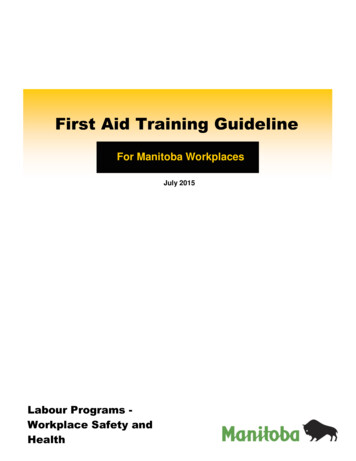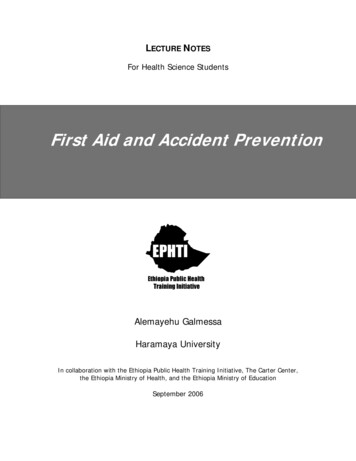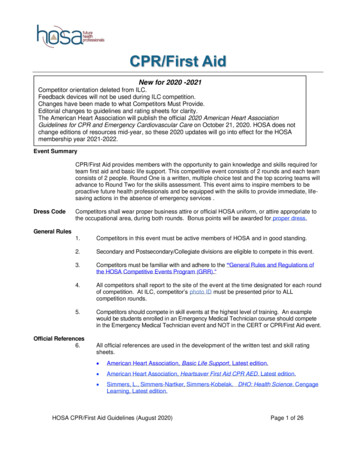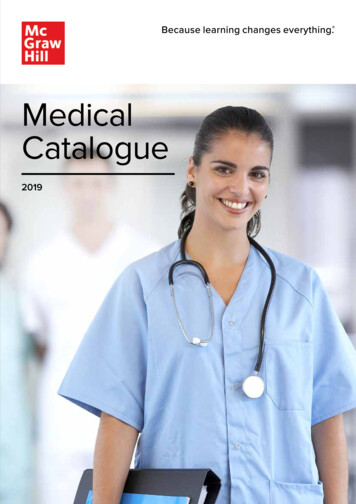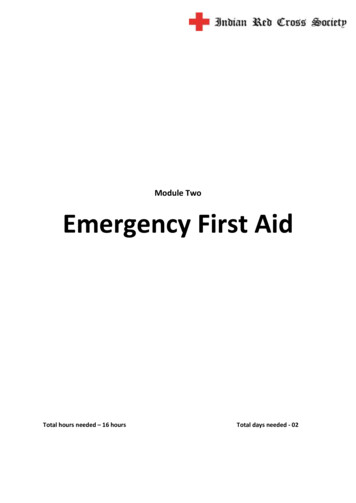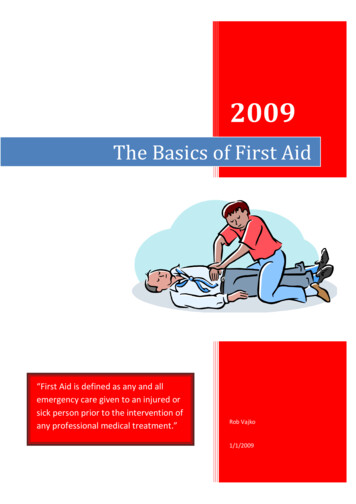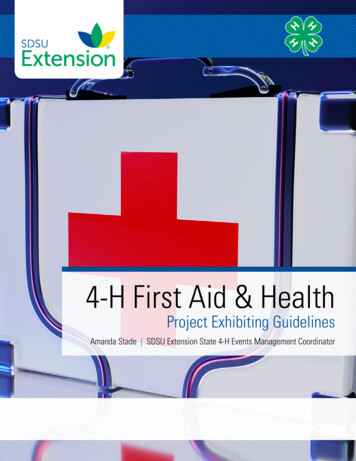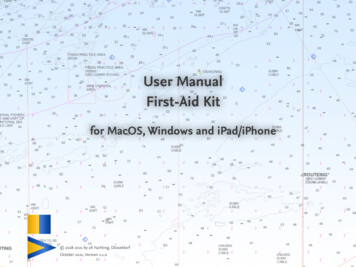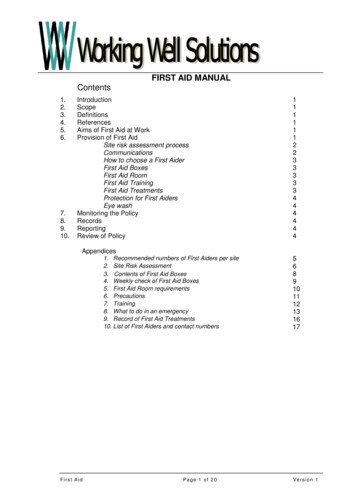
Transcription
FIRST AID peDefinitionsReferencesAims of First Aid at WorkProvision of First AidSite risk assessment processCommunicationsHow to choose a First AiderFirst Aid BoxesFirst Aid RoomFirst Aid TrainingFirst Aid TreatmentsProtection for First AidersEye washMonitoring the PolicyRecordsReportingReview of Policy1111112233333444444Appendices1. Recommended numbers of First Aiders per site2. Site Risk Assessment3. Contents of First Aid Boxes4. Weekly check of First Aid Boxes5. First Aid Room requirements6. Precautions7. Training8. What to do in an emergency9. Record of First Aid Treatments10. List of First Aiders and contact numbersFirst AidPage 1 of 205689101112131617Version 1
FIRST AID ncy First Aider – xxxxxxxedFirst Aider – An employee who has been trained to competently administer first aid atwork and holds a current ‘First Aid at Work’ certificate and appointed by the company.Occupational Health Adviser/Nurse – Able to give first aid and take charge of first aidprovision on sites3.REFERENCESThe Health and Safety at Work etc Act 1974Management of Health & Safety at Work Regulations 1999 (MHSAW)The Health and Safety (First Aid) Regulations 19814.RESPONSIBILITIES OF FIRST AIDER 5.To preserve life until medical help arrivesTo limit the effects of the injury or illnessTo evacuate the casualty safelyTo promote recoveryTo get the casualty medical help if requiredPROVISION OF FIRST AID6.1Site risk assessment processIt is not possible to give hard and fast rules about the numbers of First Aiders requiredon each site or situation. This will depend on the circumstances and situation of theworkplace and the hazards and risks present. However, the Health and SafetyExecutive has given some general guidelines (Appendix 1) to be followed bearing inmind the checklist to be used in Appendix 2. It should be noted that the minimumrequirement is for an emergency first aider to be present when there are workers onsite.6.2CommunicationAll arrangements for First Aid must be brought to the attention of all employees. Forvisitors and the self-employed it is important that they are aware of localarrangements. Checks should be made to ensure liability insurance cover wouldapply. In the event of an incident requiring First Aid, procedures should be in place toensure immediate notification and release of a First Aider. Tannoy systems or pagerscould be used. On larger sites it may be necessary to have a ‘duty’ first aider to avoidconfusion when calling for First Aid personnel.6.3How to choose a First AiderThere are some basic qualities which will be needed:First AidPage 2 of 20Version 1
6.4Calm in a crisisTrusted by their co-workersAble to pass an examination – practical and writtenPhysically able to give CPRAble to leave their work at short noticeHave an interest in health and safetyFirst Aid boxesContainers for First Aid equipment can be boxes, bags or cupboards and should bemade of material able to protect the contents from damp and dust. Containers shouldbe marked with a white cross on a green background. There should be at least onebox per site.The contents of the First Aid containers are covered by the First Aid Regulations andthe type of dressings etc should be determined by risk assessment and agreed withOccupational Health or Health and Safety. The contents of the container should beregularly checked and replenished, usually by First Aid personnel. See Appendix 3for the standard contents. See Appendix 4 for signature checking chart.Blue metal detectable plasters should be checked to ensure that they are detectableand records kept supporting this (required for audit purposes).Those who work off site or travel on behalf of the company should be given apersonal first aid kit.6.5First Aid RoomThe need for a First Aid room will be assessed from the risk assessment process (seeabove) and will not be required on all sites. Appendix 5 sets out the requirements fora first aid room6.6First Aid TrainingAll First Aiders must attend a HSE approved training course and hold a currentcertificate for First Aid at Work from the training organisation. The trainingorganisation should be made aware of any special hazards on site so that relevantFirst Aid training is received.Initial training is normally of 4 days duration with a practical and written test at the endof the taught course. The First Aid at Work certificate is valid for 3 years with a 2-dayre-qualification period required before the 3-year expires. It should be noted that if thecertificate expiratory date is over one month, then a full 4-day course is required toreceive a valid certificate. Appendix 7 sets out the typical First Aid course content.New guidance from the HSE suggests that First Aiders and Emergency First Aidersshould undertake annual refresher training over half a day during any 3 year period tokeep skills up to date.First Aid training records and lists of First Aiders will be kept in a readily accessibleformat for audit and inspection purposes e.g. HR or Security (Appendix 10).6.7First Aid TreatmentsAll First Aid staff should only give treatments for which they have been trained. Theprocedures for giving First Aid are set out in the First Aid Manual of St JohnFirst AidPage 3 of 20Version 1
Ambulance, St Andrew’s Ambulance Association and the British Red Cross Handbook(ISBN 10 0751337048) or a manual as provided by HSE recognised trainer.Basic life support and emergency procedures are included in Appendix 8.6.8Protection for First AidersAll First Aid staff who regularly treat cuts and come into contact with blood shouldensure that they follow safe handling procedures to protect themselves against bloodborne viruses such as Hepatitis B and HIV. In case of contamination or body fluidspills follow the procedures outlined in Appendix 6.6.9Eyewash bottles and EquipmentThis equipment should be considered as First Aid equipment and maintained as such.6.MONITORING THE POLICYHealth and Safety and/or Occupational Health & Wellbeing will audit 5% of all entries in theAccident book that require treatment.7.RECORDSAll accidents at work must be recorded in the Accident Book. The First Aider will makerecords of all treatment given at the time of the incident. (Appendix 9)8.REPORTINGFirst Aid staff will report to Occupational Health and Safety regarding First Aid matters butto the line manager for all other duties.9. REVIEW OF THE POLICY/PROCEDUREThis procedure will be reviewed 2 yearly or if changing legislation indicates andcommunicated to all Health and Safety personnel.First AidPage 4 of 20Version 1
NUMBERS OF FIRST AID PERSONNEL REQUIRED AS RECOMMENDED BY HSE Appendix 1Category of riskNumber employedat any locationSuggested number of FA personnelLower riske.g. offices librariesFewer than 50At least one emergency first aider50 –100At least one FA’erMore than 100One additional FA’er for every 100 employedFewer than 20At least one emergency first aider20 –100At least one FA’er for every 50 employedMore than 100One additional FA’er for every 100 employedFewer than 5At least one emergency first aider5-50At least one FA’erMore than 50One additional FA’er for every 50 employedWhere there arehazards for whichadditional skills arenecessaryIn addition, at least one FA’er trained in the specific emergency actionMedium Riske.g. light engineering and assembly work, simplefood processing, warehouseHigher riske.g. most construction, chemical manufacturers,work with dangerous machinery or sharpinstrument, bakeries and complex mechanisedfood production areas.
Appendix 2FA (FA) RISK ASSESSMENT FOR XXXX SITERisk assessment conducted by. Date Areas covered .Aspects to considerImpact on FA provision1. Person appointed to take total chargeof FA arrangements. Localarrangements will apply on sites2. Suitably stocked & numbers of FAboxes (see appendix 1)This person will need to hold therecords of training, arrange suppliesof equipment on request etcBear in mind the type of injuries to betreated, review previous injury historyto ensure relevant issues consideredTake into account holiday, cover forsickness and all shift times.3. Are there suitable and sufficient firstaiders / emergency first aiders tocover the area? (see appendix 2)4. Information to employees on first-aidarrangements5. What are the risks of injury and illhealth arising from the work asidentified in risk assessment?6. Are there any specific risks, e.g. Hazardous substances Dangerous tools Dangerous machinery Confined spaces or heights7. Are locations where different levels ofrisk can be identified?8. What type of accidents and ill healthhave you had in the past? What typeand where? How to access Who local first-aider is What to do in an emergencyIf the risks are significant more FA’smay be neededConsider: Specific training for FA’s Extra FA equipment Precise siting of FA equipment Informing emergency services FA roomMay need to make different levels ofprovision in high risk areasMay need to: Locate provision in certain areas Review contents of FA boxesCurrently in placeAreas needing addressing
9. Are the premises spread out or multifloor buildingsConsider provision in each buildingor on several floorsAspects to consider10. Is there shift work or out of hoursworking?11. How far away is the local hospital?Impact on first-aid provisionRemember FA provision required atall times people are at workDo you need to: Inform local medical services ofhazardous work/substances Consider special arrangements inevent of mishap12. Do employees have to travel onbusiness or work alone? Issue personal FA kits and trainingstaff on use Issue instructions on what to do inan emergencyMake arrangements with the siteoccupiersRemember FA provision must coverthemThe HSE recommends that the publicand visitors are to be covered by FAprovisionMake special arrangements tocommunicate first-aid informationespecially where English is not thefirst language.13. Do any of your employees work atsites occupied by other employers?14. Do you have any work experiencetrainees?15. Do members of the public visit yourpremises?16. Do you have employees with readingor language difficulties?Other areas considered addressing?(State)How many First Aiders and Emergencyfirst aiders are required for this site?(State)For further information refer to the First Aid at Work RegulationsCurrently in placeAreas needing addressing
Completed by (signed) (Name) Completed by (signed) (Name) Completed by (signed) (Name) Completed on date .Date of review
Appendix 3BASIC FIRST AID BOX CONTENTSCONTENTS REQUIRED FOR 10-20 PERSON BOXCONTENTS FOR INDIVIDUALS / CAR DRIVERS A leaflet giving general guidance on FA A leaflet giving general guidance on FA 20 individually wrapped sterile adhesive plasters (assorted sizes) 6 individually wrapped sterile adhesive plasters / dressings 2 sterile eye pads 1 sterile eye pad 6 triangular bandages (individually wrapped) 2 triangular bandages (individually wrapped) 6 safety pins 6 safety pins 10 individually wrapped wipes 6 individually wrapped wipes 6 medium size individually wrapped wound dressings (12 cm x 12cm) 1 medium size individually wrapped wound dressings 3 large size individually wrapped wound dressings (18cm x 18cm) 1 large size individually wrapped wound dressings 2 pairs of disposable gloves 1 pair of disposable gloves Indicate if there are additional items required as standard Indicate if there are additional items required as standardIn food production units, waterproof blue detectable plasters are advisable. These must be metal detectable if required by customers.In addition to the items above:1.Soap and water and disposable drying materials should also be available.2.Where tap water is not available for eye irrigation, disposable, sterile eye irrigators must be used. At least 1 litre must be readily available.3.Aprons if required, or any other suitable protective equipment, should be provided in or near the First Aid Box.
Appendix 4WEEKLY CHECK OF FIRST AID BOXLocation of boxSignature Serviced w/cSignature Serviced w/cSignature Serviced w/cSignature Serviced w/c
Appendix 5First Aid Room RequirementsRooms 1 room large enough for a couch and to keep First Aid suppliesPreferably ground floor because of accessEntrance wide enough for stretcher/wheelchair accessVentilation by windows or wall ventClose access to toiletFixed Equipment Sink with elbow or automatic tapsKitchen-type base units and wall cupboardsTelephone with facility to dial outNotice boardPortable Equipment Examination couch with step upPillows with disposable pillowcasesBlanketsDisposable sheet rollTransport chairsWaste paper binClinical Waste bin, check waste carrier and disposal notesSharps BoxChairs (2)Medical Equipment Large emergency first aid boxEyewash bottles to replenish site and used bottlesDressingsBlunt ended scissorsTissues and paper towelsVomit bowlsDisposable glovesOther SoapHand creamAccident bookEmergency contact telephone numbers on notice boardList of first aiders on siteClinical waste collection and disposal contract
Appendix 6First Aid PrecautionsContamination can occur when body fluids gain entry through the skin or mucous membranes suchas the eyes or mouth. It is always safest to assume that all body fluids carry some infection and takeadequate precautions to prevent contamination.Types of InfectionThere are mainly three types of common infections (although there are others): Hepatitis B virus (HBV)Hepatitis C virus (HCV)Human Immunodeficiency Disease (HIV)Prevention of incidents Waterproof dressings should be used to dress cuts and grazes as these may be potential routesof infectionWhen dealing with any blood or bodily fluids protective clothing should always be wornWash your hands after dealing with any incident involving blood or body fluidsEnsure all contaminated/protective equipment is disposed of in clinical waste binsProtective clothingGlovesWhilst still penetrable, gloves reduce the risk of transmission of infection.Wearing an outer and an inner glove reduces this risk even further.ApronWill protect the individual from splashes and spills from cleaning anddripping wounds.Management of blood and body fluid exposure incidentsFirst aid treatment If the mouth or eyes are involved, they should be washed thoroughly with water. If skin is punctured, free bleeding should be gently encouraged and the wound should bewashed with soap and water but not scrubbed or suckedAll exposure incidents should be reported promptly to Occupational Health. This is important forthree reasons. To ensure appropriate management to reduce the risk of blood-borne virus transmission To document the incident and the circumstances of it.The management of an incident will be as determined by the local Occupational Health Adviser butreferral to A&E may be indicated.Exposures to hepatitis B or C or HIV are reportable to the Health and Safety Executive, under theReporting of Injuries Diseases and Dangerous Occurrences Regulations 1995(RIDDOR) as adangerous occurrence
Appendix 7TRAINING SCHEDULEFirst Aid at Work (FAW) - Course InformationStudents will receive training in the First Aid at Work (FAW) competencies: Aims and Rules of First Aid at Work (FAW)Basic Life SupportTreatment of the unconscious casualtyTreatment of a casualty who is wounded, bleeding or shockedTreatment of fractures, dislocations and soft tissue injuriesTreatment of burns, poisoning and eye injuriesTreatment of common major and minor illnessesPrevention of cross-infection during First Aid at Work (FAW) proceduresEmergency transport of casualtiesLegal aspects of First Aid at Work (FAW)First Aid at Work (FAW) Course CertificateAfter successful completion of the taught course and a final practical assessment, the student will beawarded the HSE recognised, First Aid at Work (FAW) Certificate which is valid for 3 years.First Aid at Work (FAW) Course (4 Days)First Aid at Work Refresher Course (2 Days)For those who hold a FAW Certificate that is about to expire. Your FAW Certificate is valid for 3 years andyou must re-qualify within one month of certificate expiry if you want to avoid having to do the full 4-daycourse again.Emergency First Aid Course (1 Day) Emergency first aider
Appendix 8What to do in an EmergencyPrioritiesYour priorities are to: Assess the situation – do not put yourself in danger; Make the area safe; Assess all casualties and attend first to any unconscious casualties; Send for help – do not delay.Check for a responseGently shake the casualty’s shoulders and ask loudly, ‘Are you all right?’ If there is noresponse, your priorities are to: Shout for help; Open the airway; Check for normal breathing; Take appropriate action
Source Health and Safety Executive 2008
Appendix 9RECORD OF FIRST AID MENT GIVENCOMPLAINTSIGNATUREWork10HomeGPHosp
Appendix 10LIST OF FIRST AIDERS & CERTIFICATEEXPIRY DATESNAMEDEPTCERT EXPIRY DATECONTACT
All First Aid staff should only give treatments for which they have been trained. The procedures for giving First Aid are set out in the First Aid Manual of St John . First Aid Page 4 of 20 Version 1 Ambulance, St Andrew’s Ambulance Association and the British Red Cross Handbook (ISBN 10
